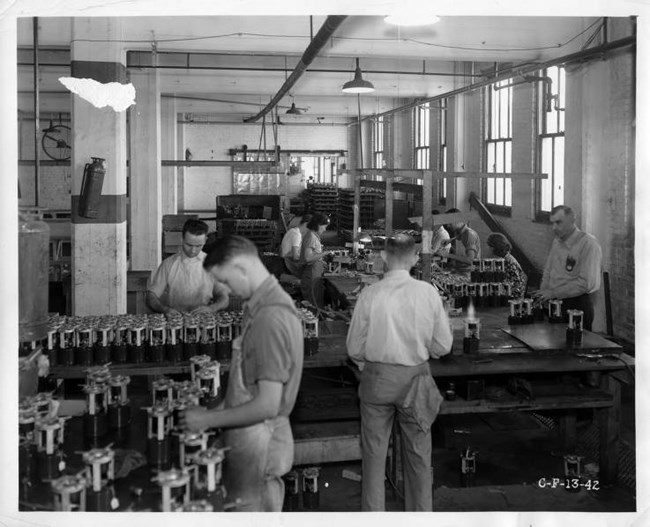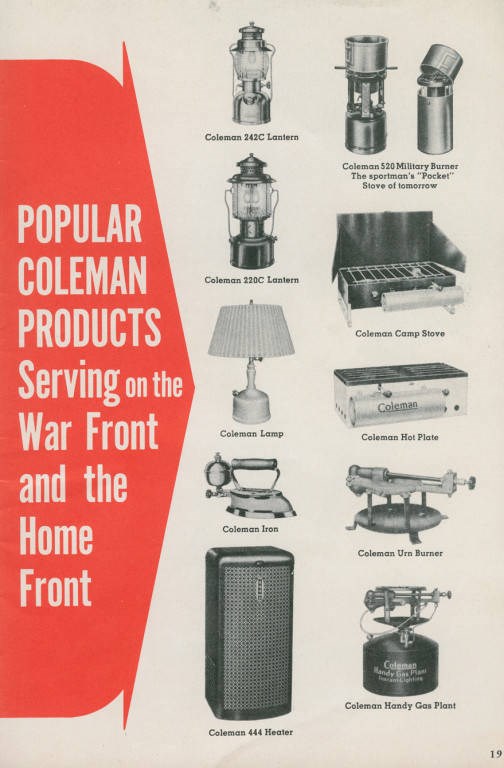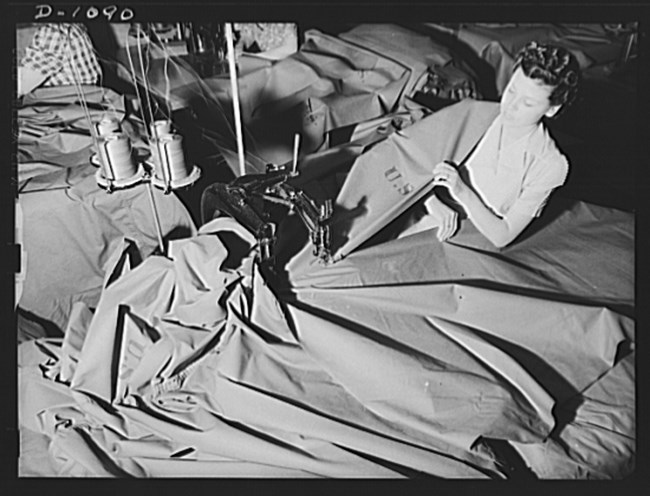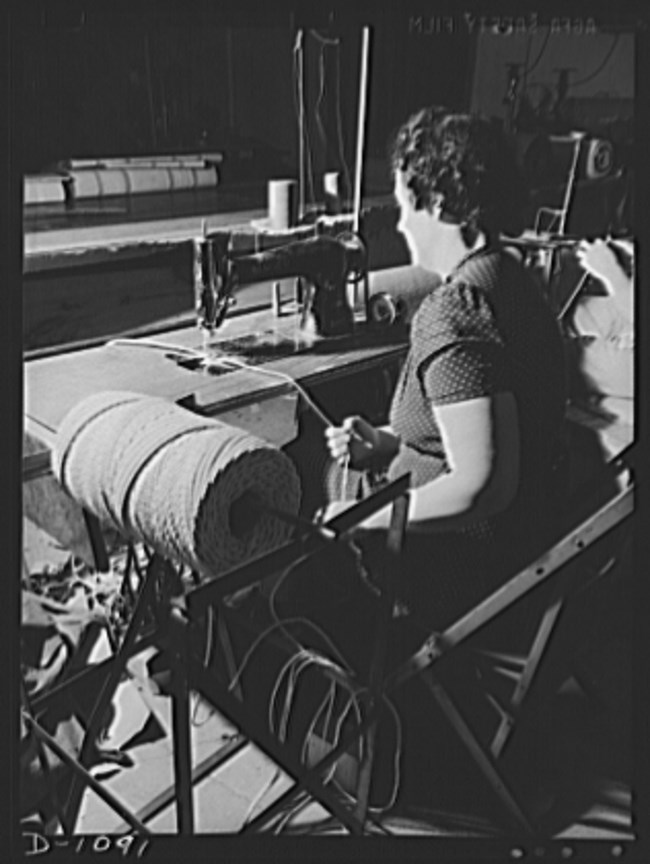Part of a series of articles titled Wichita, KS, WWII Heritage City Lesson.
Article
(H)our History Lesson: Defense Manufacturing in Wichita, Kansas, World War II Heritage City

(Courtesy of Wichita State University Libraries, Special Collections and University Archives; wsu_ms2013-03_38_41_001_01
About this Lesson
This lesson is part of a series teaching about the World War II home front, with Wichita, Kansas designated as an American World War II Heritage City. The lesson contains three primary reading sources and photos to contribute to learners’ understandings on defense manufacturing with examples from Wichita, Kansas: the Coleman Lamp and Stove Company and Langdon Tent and Awning Company. Women were also employed at both companies as defense workers.
To see more lessons about World War II, visit Teaching with Historic Places.
Objectives:
-
Identify examples of defense manufacturing in Wichita, Kansas.
-
Describe the benefits of the products made by companies to the war efforts.
-
Evaluate the importance of the contributions of home front workers to defense manufacturing.
Materials for Students:
-
Photos (can be displayed digitally)
-
Readings 1, 2, 3
-
Recommended: map of Wichita, Kansas
Getting Started: Essential Question
How did defense manufacturing on the home front in Wichita, Kansas contribute to the war efforts?

Courtesy of Wichita State University Libraries, Special Collections and University Archives; wsu_ms2013-03_38_41_001_01
Quotation to consider:
“The men and women of Coleman who are fighting the ‘Battle of Production,’ are as truly serving the war effort as this kid from Kansas who is playing ‘Leap Frog’ among the Japanese Islands of the Pacific! Coleman needs additional men and women to help keep the even flow of vital materials going to all the world’s fighting fronts. Won’t you enlist in the Coleman Production Army?”
-From an ad by the Coleman Lamp and Stove Company in The Wichita Eagle, November 7, 1943, p.11
Read to Connect
Teacher Tip: Reading 3 shares on decalcomania as additional production at the Coleman Lamp and Stove Company and can be read directly after this reading, or as an extension.
Coleman Company Highly Commended for its War Work
Army-Navy “E” Award Presented to Firm’s Officials Here Friday Night, Triple Production
The Wichita Eagle, June 24, 1944; p.3
'Each of us must do the job that falls to our lot—the job that we are best trained to do—and do it well if we are to bring this war to an early conclusion,’ Lieut. Col. Wendell S. Holmes, executive officer of the procurement district, Washington, D.C., told hundreds of Coleman Lamp and Stove company officials and employees who gathered at the Arcadia last night for the presentation of the army-navy “E” award to the company.
Holmes, a graduate of the University of Kansas, revealed that just before leaving Washington he had read a military intelligence report from a certain front which stated that the one-burner stove which Coleman makes is considered the third most important item of individual equipment which our soldiers have. ‘And some time ago, Ernie Pyle, the famous war correspondent who lived and marched with our army during cold desert nights in North Africa and the rains and mud of Italy, gave it first place,’ he added.
‘I want to point out,’ Colonel Holmes asserted, ‘that beginning with the declaration of the emergency you had doubled your peace time production by the beginning of 1943, and on the basis of reports for the first three months of this year, you will have tripled it for 1944. For this record, you deserve the thanks and commendation of a grateful nation.
Make Major Contribution
‘We all should take particular pride in the fact the men and women of Coleman’s never have slowed down war production. On the contrary, you have speeded it up to meet grace emergency demands. You have produced the supplies we wanted and when we wanted them. Through your own loyalty and efforts, you have made a major contribution to the war effort.
I am here tonight to help you celebrate your well-earned success by presenting to you on behalf of the war and navy departments the army-navy “E” award for excellent performance. As a citizen and as a soldier, I take pride in presenting you this flag, the symbol of a job well done.’
The presentation of the flag by Colonel Holmes was made to Sheldon Coleman, vice president and general manager of the company, and Owen Gahman, a veteran employee with more than 35 years of service to the firm.
W.C. Coleman, president of the company, was master of ceremonies. He paid high tribute to the workers in securing the ‘E’ award for the firm and to the distinguished guests present for the impressive rites.
Lieut. Commander Richard W. Schlect, of the navy recruiting office, Kansas City, Mo., presented the ‘E’ pins to the employees, with Owen Gahman accepting them on behalf of the company.
Teacher Tip: Part A is sharing about the company’s manufacturing in 1940 – their “first such order.” Part B shows the continued manufacturing of the company nearly five years later, in 1945.
Part A:
Contract is Given Wichita Firm for 75,000 Pup Tents
Must be Delivered to Government Within 135 Days; Will Increase Payroll; First Such Order
The Wichita Eagle, September 26, 1940, P. 5
Airplanes are not the only commodities manufactured at local plants useful to the national defense.
Langdon Tent & Awning company, yesterday was awarded a contract to supply the war department with 75,000 pup tents. J.C. Dunlap, vice president and general manager of the company, said the government had specified a time limit of 135 days in fulfilling the contract. The company has installed special equipment and will employ 50 additional people to fill the order, which is believed to be the first of its kind ever received by a local firm.
Pup tents, made of two shelter-halves, are essential equipment of each soldier’s pack. Each soldier carries a shelter-half. At night encampment soldiers are paired off and make a pup tent by buttoning their shelter-halves together. The tent provides accommodations for two solders.
Part B:
Wichita Company to Make Leggings for U.S. Soldiers
Langdon Tent and Awning Concern Completing Big Pup Tent Contract, To Expand Factory
The Wichita Eagle, April 9, 1945; p. 5
Near completion on two war department pup tent contracts, the Langdon Tent and Awning company of Wichita last night was awarded a third contract of $100,000 for 130,000 canvas leggings for delivery within 210 days to the army, company officials announced.
Planning expansion of the plant at 1500 East Douglas, company officials declared they intend to finish the order a month early. The leggings to be made are the lace-on kind and not the wrap-on kind, which are a back number in modern warfare.
The last of the pup tent orders is being completed. The tents have been shipped as far away as Hawaii and Schenectady, N.Y. . . .
Contract is Confirmed
Ward said the contract was closed in telephone conversation with army officers at the Philadelphia quartermaster depot, and that a confirmation by telegraph has been received. The company, Ward said, may need additional skilled workers to complete the order on time.
The Langdon company, he declared, has received orders from the war department almost as large as any other company in the United States making leggings, pup tents, and similar goods. The pup tent order—the official army name is shelter tent—is for 175,000 tents at $75,000. This order, Ward said, will be completed in a month or 40 days.
Teacher Tip: This reading expands on Reading 1 with details on products manufactured by the Coleman Lamp and Stove company. It can be omitted if focusing on just two readings/examples of defense manufacturing, used as a third reading, or as an extension reading to Reading 1.
Define ‘decalcomania’ with students: the process of transferring designs from prepared paper to other surfaces.
Use Coleman Product All About World
Decalcomania Process Puts Designs on Airplanes in Few Minutes
Wichita Evening Eagle, September 14, 1943, p.11
When H.W. Morton started the decalcomania process at Coleman Lamp and Stove company over seven years ago, it was generally thought that Coleman would employ the process for its own use exclusively. For some time Morton’s department furnished Coleman with product ‘decals.’
Gradually, as they improved and developed the process, the Coleman method began to attract attention. Through the years, Coleman did more and more outside business, supplying oil companies with display materials and ‘decals’ for insignia to be used on their trucks, until finally the decalcomania process had cemented itself to the Coleman organization and had become one of the permanent divisions of the plant.
Morton said yesterday that the earliest beginnings of this process were in Europe. ‘In the early days,’ he explained, ‘this process was used almost exclusively in decorating china and glassware. The central jobber marketed wares produced by individual families in the village. The decalcomania process was established so that a uniform design could be produced.’ Morton explained that the original process was then expanded for use in reproducing designs. ‘But it remained for the Americans to commercialize this process for industrial use.’
One of the most desirable features of the decalcomania process was its speed of application. A design can be transferred to any object in three to four minutes, each transfer being equivalent to eight coats of paint. Such an application would require a painter with a mask and spray three to four hours for coating, and that each coat would have to be allowed to dry before continuing the operation. The decals are made in mass quantities.
Today Coleman here in Wichita supplies the local defense and aircraft factories with designs for their planes and trucks. Ninety-five percent of the ‘decals’ used in Wichita come from the Coleman plant. On airplanes, the insignias showing on the outside, as well as serial numbers, and other visible designs, are all applied with the decalcomania process. Coleman also has perfected a decalcomania process with fluorescent and phosphorescent paint for instrument panel markings and identification, so applied that they will be luminous in the dark.
Coleman supplies defense and aircraft factories all over the United States with products from their ‘decal’ department. Their business has even stretched over into Canada, and Coleman has supplied many of the Royal Canadian air force insignia. When the U.S. air force planes adopted the new insignia, consisting of the present white star on a circular field of blue with a white rectangle attached horizontally at the right and left of the circle and surrounded be a red border, Coleman was one of the first suppliers to make delivery of decals of this new insignia, and many of the planes flying over Wichita with the new insignia have Coleman-made decals on their wings.
Morton said that Coleman is rated one of the high quality decalcomania manufacturers in the United States, and have received several awards of merits from aircraft builders for efficiency and speed in delivery.

Library of Congress
Student Activities
Questions for Reading 1, Photos 1-2, and Quotation
1. In Photo 2, why would Coleman highlight products being used on the “war front” and the “home front” in their booklet? (You may also choose to explore other pages in “How Soldiers Cook at the Fighting Fronts.")
2. What is the significance of the one-burner stove produced by the Coleman Lamp and Stove company according to Colonel Holmes?
3. How did the employees of Coleman Lamp and Stove company contribute to the war effort, and what specific recognition did they receive for their efforts?
4. What was the symbolism of awarding defense manufacturers the army-navy “E” award during wartime?
Questions for Reading 2 and Photos 3-4
-
What contracts were awarded to the Langdon Tent and Awning company?
-
In photos 3 & 4 (above and below), who is working at the company? How do the pictures help you visualize the production process?
-
What are pup tents?
- Why was this production in Wichita important to the army?
By the numbers:
Carefully consider the numbers shared in Reading 2.
Calculate: In part A, how many pup tents would need to be made per day? In part B, How much was the army paying per pair of canvas leggings produced? How many canvas leggings would need to be made each day for the contract? Repeat the same process for the pup tent order in part B.

Library of Congress
Questions for Reading 3
-
What is the usefulness of decalcomania, developed by H.W. Morton?
-
What does Coleman supply to local defense and aircraft factories? And, to the Royal Canadian Air Force and U.S. air force?
-
How did innovation by the Coleman company improve efficiency in home front efforts?
Lesson Closing
-
Consider the types of products described in readings 1-3. Why was it important that the U.S. and its Allies were producing diverse products during wartime?
- Reflect on the essential question: How did defense manufacturing on the home front in Wichita, Kansas contribute to the war efforts?
This lesson was written by Sarah Nestor Lane, an educator and consultant with the Cultural Resources Office of Interpretation and Education, funded by the National Council on Public History's cooperative agreement with the National Park Service.
Tags
- world war ii
- world war 2
- wwii
- ww2
- world war ii home front
- wwii home front
- home front
- american world war ii heritage city program
- awwiihc
- teaching with historic places
- twhp
- twhplp
- hour history lessons
- wichita
- kansas
- military and wartime history
- wartime production
- american industry
- world war ii home front mobilization
Last updated: April 9, 2024
